BUS298 - A Critical Evaluation of TQM and HPWO in Diverse Industries
VerifiedAdded on 2023/06/15
|7
|2648
|352
Essay
AI Summary
This essay provides a critical evaluation of Total Quality Management (TQM) and High-Performance Work Organisation (HPWO) as change tools, examining their effectiveness in both manufacturing and service industries. It begins by defining organisational change and the resistance it often faces, highlighting the importance of effective change management. The essay then delves into TQM, explaining its consumer-centric approach and long-term implementation, along with its core principles. Following this, the High-Performance Work Organisation is explored as a framework designed to maximize employee performance through specialization, standardization, and a focus on human resources. The similarities and differences between manufacturing and service operations are outlined, emphasizing the tangible vs. intangible nature of their outputs and the customization vs. standardization approaches. The application of TQM and HPWO in each sector is then discussed, highlighting advantages, disadvantages, and the importance of management support and employee involvement. The essay concludes that both TQM and HPWO are valuable tools for driving organisational change in both manufacturing and service contexts.
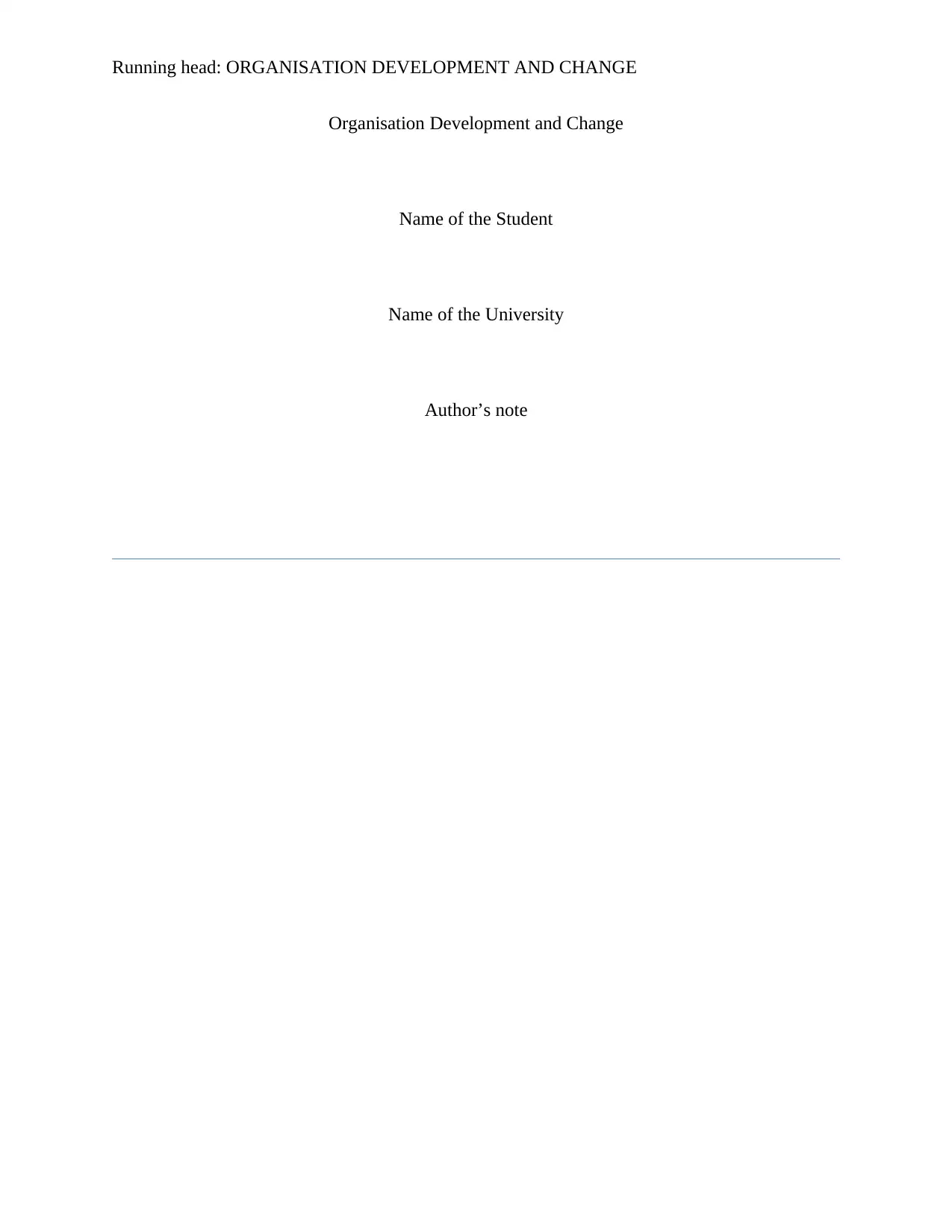
Running head: ORGANISATION DEVELOPMENT AND CHANGE
Organisation Development and Change
Name of the Student
Name of the University
Author’s note
Organisation Development and Change
Name of the Student
Name of the University
Author’s note
Paraphrase This Document
Need a fresh take? Get an instant paraphrase of this document with our AI Paraphraser
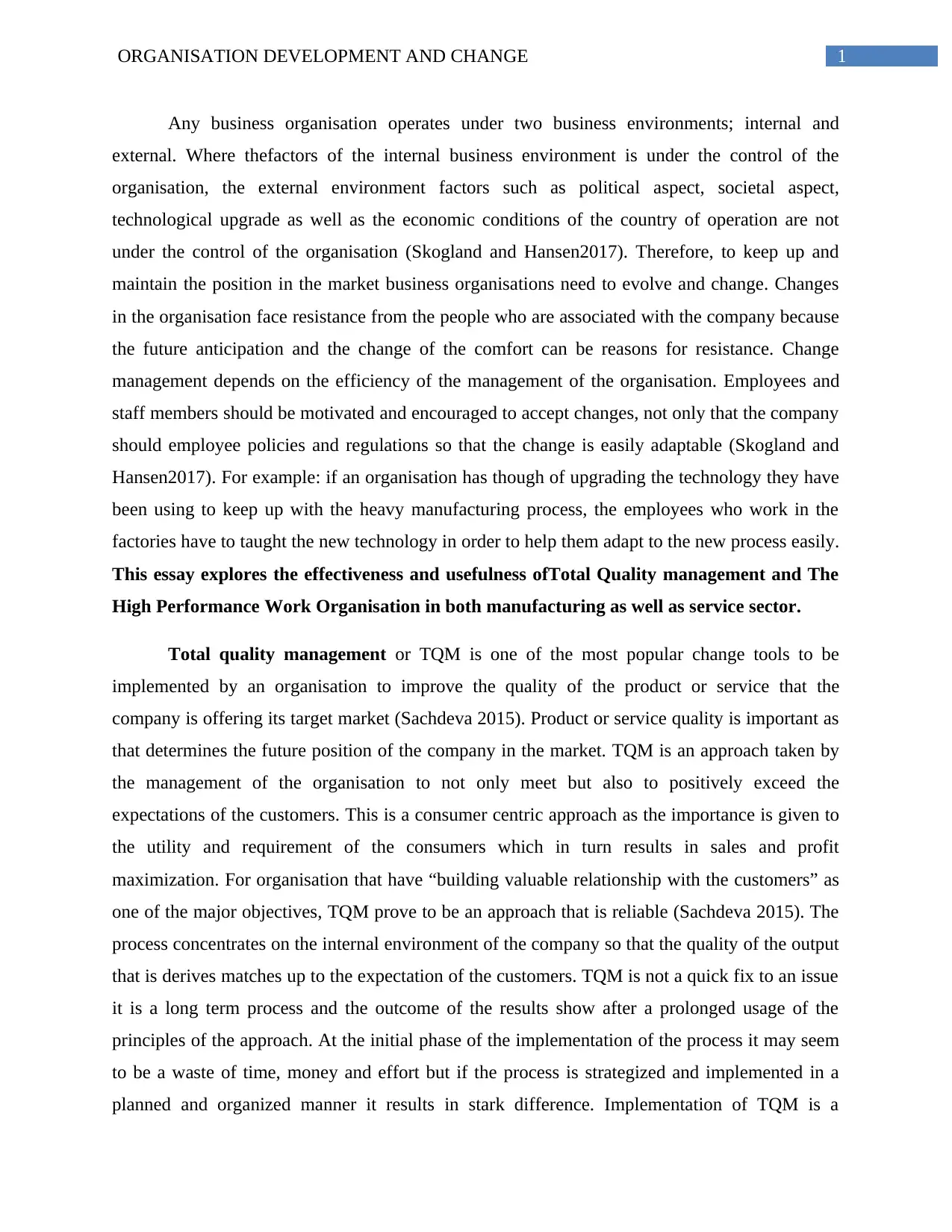
1ORGANISATION DEVELOPMENT AND CHANGE
Any business organisation operates under two business environments; internal and
external. Where thefactors of the internal business environment is under the control of the
organisation, the external environment factors such as political aspect, societal aspect,
technological upgrade as well as the economic conditions of the country of operation are not
under the control of the organisation (Skogland and Hansen2017). Therefore, to keep up and
maintain the position in the market business organisations need to evolve and change. Changes
in the organisation face resistance from the people who are associated with the company because
the future anticipation and the change of the comfort can be reasons for resistance. Change
management depends on the efficiency of the management of the organisation. Employees and
staff members should be motivated and encouraged to accept changes, not only that the company
should employee policies and regulations so that the change is easily adaptable (Skogland and
Hansen2017). For example: if an organisation has though of upgrading the technology they have
been using to keep up with the heavy manufacturing process, the employees who work in the
factories have to taught the new technology in order to help them adapt to the new process easily.
This essay explores the effectiveness and usefulness ofTotal Quality management and The
High Performance Work Organisation in both manufacturing as well as service sector.
Total quality management or TQM is one of the most popular change tools to be
implemented by an organisation to improve the quality of the product or service that the
company is offering its target market (Sachdeva 2015). Product or service quality is important as
that determines the future position of the company in the market. TQM is an approach taken by
the management of the organisation to not only meet but also to positively exceed the
expectations of the customers. This is a consumer centric approach as the importance is given to
the utility and requirement of the consumers which in turn results in sales and profit
maximization. For organisation that have “building valuable relationship with the customers” as
one of the major objectives, TQM prove to be an approach that is reliable (Sachdeva 2015). The
process concentrates on the internal environment of the company so that the quality of the output
that is derives matches up to the expectation of the customers. TQM is not a quick fix to an issue
it is a long term process and the outcome of the results show after a prolonged usage of the
principles of the approach. At the initial phase of the implementation of the process it may seem
to be a waste of time, money and effort but if the process is strategized and implemented in a
planned and organized manner it results in stark difference. Implementation of TQM is a
Any business organisation operates under two business environments; internal and
external. Where thefactors of the internal business environment is under the control of the
organisation, the external environment factors such as political aspect, societal aspect,
technological upgrade as well as the economic conditions of the country of operation are not
under the control of the organisation (Skogland and Hansen2017). Therefore, to keep up and
maintain the position in the market business organisations need to evolve and change. Changes
in the organisation face resistance from the people who are associated with the company because
the future anticipation and the change of the comfort can be reasons for resistance. Change
management depends on the efficiency of the management of the organisation. Employees and
staff members should be motivated and encouraged to accept changes, not only that the company
should employee policies and regulations so that the change is easily adaptable (Skogland and
Hansen2017). For example: if an organisation has though of upgrading the technology they have
been using to keep up with the heavy manufacturing process, the employees who work in the
factories have to taught the new technology in order to help them adapt to the new process easily.
This essay explores the effectiveness and usefulness ofTotal Quality management and The
High Performance Work Organisation in both manufacturing as well as service sector.
Total quality management or TQM is one of the most popular change tools to be
implemented by an organisation to improve the quality of the product or service that the
company is offering its target market (Sachdeva 2015). Product or service quality is important as
that determines the future position of the company in the market. TQM is an approach taken by
the management of the organisation to not only meet but also to positively exceed the
expectations of the customers. This is a consumer centric approach as the importance is given to
the utility and requirement of the consumers which in turn results in sales and profit
maximization. For organisation that have “building valuable relationship with the customers” as
one of the major objectives, TQM prove to be an approach that is reliable (Sachdeva 2015). The
process concentrates on the internal environment of the company so that the quality of the output
that is derives matches up to the expectation of the customers. TQM is not a quick fix to an issue
it is a long term process and the outcome of the results show after a prolonged usage of the
principles of the approach. At the initial phase of the implementation of the process it may seem
to be a waste of time, money and effort but if the process is strategized and implemented in a
planned and organized manner it results in stark difference. Implementation of TQM is a
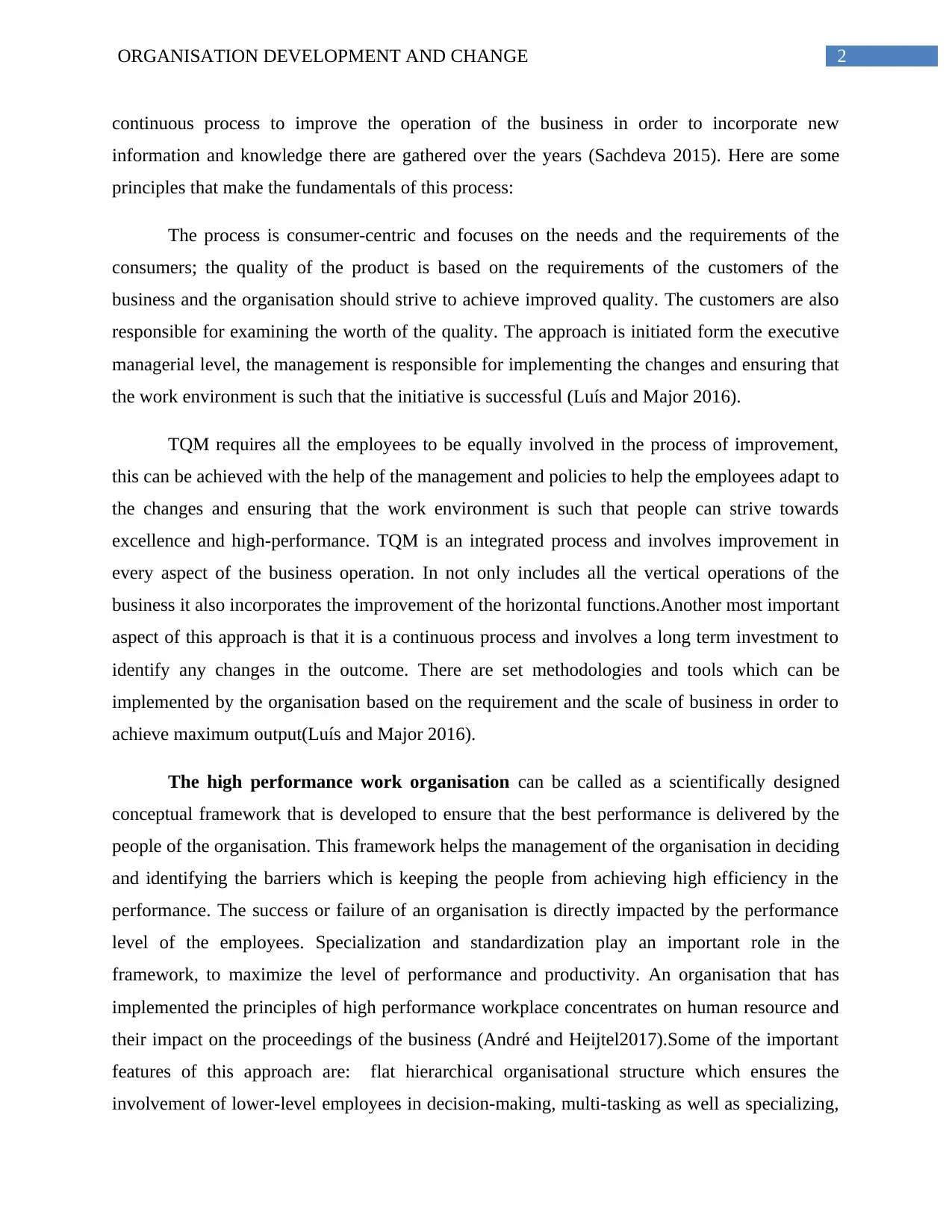
2ORGANISATION DEVELOPMENT AND CHANGE
continuous process to improve the operation of the business in order to incorporate new
information and knowledge there are gathered over the years (Sachdeva 2015). Here are some
principles that make the fundamentals of this process:
The process is consumer-centric and focuses on the needs and the requirements of the
consumers; the quality of the product is based on the requirements of the customers of the
business and the organisation should strive to achieve improved quality. The customers are also
responsible for examining the worth of the quality. The approach is initiated form the executive
managerial level, the management is responsible for implementing the changes and ensuring that
the work environment is such that the initiative is successful (Luís and Major 2016).
TQM requires all the employees to be equally involved in the process of improvement,
this can be achieved with the help of the management and policies to help the employees adapt to
the changes and ensuring that the work environment is such that people can strive towards
excellence and high-performance. TQM is an integrated process and involves improvement in
every aspect of the business operation. In not only includes all the vertical operations of the
business it also incorporates the improvement of the horizontal functions.Another most important
aspect of this approach is that it is a continuous process and involves a long term investment to
identify any changes in the outcome. There are set methodologies and tools which can be
implemented by the organisation based on the requirement and the scale of business in order to
achieve maximum output(Luís and Major 2016).
The high performance work organisation can be called as a scientifically designed
conceptual framework that is developed to ensure that the best performance is delivered by the
people of the organisation. This framework helps the management of the organisation in deciding
and identifying the barriers which is keeping the people from achieving high efficiency in the
performance. The success or failure of an organisation is directly impacted by the performance
level of the employees. Specialization and standardization play an important role in the
framework, to maximize the level of performance and productivity. An organisation that has
implemented the principles of high performance workplace concentrates on human resource and
their impact on the proceedings of the business (André and Heijtel2017).Some of the important
features of this approach are: flat hierarchical organisational structure which ensures the
involvement of lower-level employees in decision-making, multi-tasking as well as specializing,
continuous process to improve the operation of the business in order to incorporate new
information and knowledge there are gathered over the years (Sachdeva 2015). Here are some
principles that make the fundamentals of this process:
The process is consumer-centric and focuses on the needs and the requirements of the
consumers; the quality of the product is based on the requirements of the customers of the
business and the organisation should strive to achieve improved quality. The customers are also
responsible for examining the worth of the quality. The approach is initiated form the executive
managerial level, the management is responsible for implementing the changes and ensuring that
the work environment is such that the initiative is successful (Luís and Major 2016).
TQM requires all the employees to be equally involved in the process of improvement,
this can be achieved with the help of the management and policies to help the employees adapt to
the changes and ensuring that the work environment is such that people can strive towards
excellence and high-performance. TQM is an integrated process and involves improvement in
every aspect of the business operation. In not only includes all the vertical operations of the
business it also incorporates the improvement of the horizontal functions.Another most important
aspect of this approach is that it is a continuous process and involves a long term investment to
identify any changes in the outcome. There are set methodologies and tools which can be
implemented by the organisation based on the requirement and the scale of business in order to
achieve maximum output(Luís and Major 2016).
The high performance work organisation can be called as a scientifically designed
conceptual framework that is developed to ensure that the best performance is delivered by the
people of the organisation. This framework helps the management of the organisation in deciding
and identifying the barriers which is keeping the people from achieving high efficiency in the
performance. The success or failure of an organisation is directly impacted by the performance
level of the employees. Specialization and standardization play an important role in the
framework, to maximize the level of performance and productivity. An organisation that has
implemented the principles of high performance workplace concentrates on human resource and
their impact on the proceedings of the business (André and Heijtel2017).Some of the important
features of this approach are: flat hierarchical organisational structure which ensures the
involvement of lower-level employees in decision-making, multi-tasking as well as specializing,
⊘ This is a preview!⊘
Do you want full access?
Subscribe today to unlock all pages.

Trusted by 1+ million students worldwide

3ORGANISATION DEVELOPMENT AND CHANGE
responsible and motivated teams as well as individual workers. As the approach is Human
resource centric the organisation invests in the supports of learning and developing skills and
expertise. Technical, creativeas well as communication and social skills are paid attention in the
process of learning and development, this approach provides opportunities for the employees of
the organisation to grow and expand their career as well. The approach promotes and encourages
healthy interpersonal relationship among the workers as well as in between the management and
the staff members of the organisation so that grievances and issues of the people which is the
greatest hindrance to high performance areresolved. The outcome of this approach is that the
performance of the employee ensures the output of the organisation is of improved form. As
innovation plays an important part of the approach it ensures that the process will include
procedures that is new and of improved quality(Aakanksha 2014).
Business organisations provide either product or services to the target market in order to
earn revenue and keep the cash flowing in the business. An organisation that operates in the
product industry manufactures the product in order to make it available for the customers for
example any electronic or FMCG products, on the other hand the business enterprises that
operate in the service industry like tourism and health care provide the consumers with services
in exchange for money. Similarities between manufacturing and service operations are:
achieving valuable relation with the consumers, a process of inputs and outputs are involved in a
business enterprise weather it is service or goods operations. Use of technology is also a common
aspect of the operations, structure of the upper level management remains the same.
Some of the differences on the operation are: the approach is different; service industry is
more associated with the people whereas product industry is based on the product itself; one of
the most obvious differences is the tangible aspect of the output. Customization vs.
Standardization is another point of difference, a product is manufactured in the factory in bulk
and those are send to be sold to the customers, the products from a company are standardized and
similar and cannot be changed according to the preference of each customer, where as the
services are customizable in nature for example: the service of a doctor depends on the ailment
and the intensity of the issue.
Application of TQM in the manufacturing industryincludes understanding of the
requirement o the customers and then manipulating the existing product as per the expectation of
responsible and motivated teams as well as individual workers. As the approach is Human
resource centric the organisation invests in the supports of learning and developing skills and
expertise. Technical, creativeas well as communication and social skills are paid attention in the
process of learning and development, this approach provides opportunities for the employees of
the organisation to grow and expand their career as well. The approach promotes and encourages
healthy interpersonal relationship among the workers as well as in between the management and
the staff members of the organisation so that grievances and issues of the people which is the
greatest hindrance to high performance areresolved. The outcome of this approach is that the
performance of the employee ensures the output of the organisation is of improved form. As
innovation plays an important part of the approach it ensures that the process will include
procedures that is new and of improved quality(Aakanksha 2014).
Business organisations provide either product or services to the target market in order to
earn revenue and keep the cash flowing in the business. An organisation that operates in the
product industry manufactures the product in order to make it available for the customers for
example any electronic or FMCG products, on the other hand the business enterprises that
operate in the service industry like tourism and health care provide the consumers with services
in exchange for money. Similarities between manufacturing and service operations are:
achieving valuable relation with the consumers, a process of inputs and outputs are involved in a
business enterprise weather it is service or goods operations. Use of technology is also a common
aspect of the operations, structure of the upper level management remains the same.
Some of the differences on the operation are: the approach is different; service industry is
more associated with the people whereas product industry is based on the product itself; one of
the most obvious differences is the tangible aspect of the output. Customization vs.
Standardization is another point of difference, a product is manufactured in the factory in bulk
and those are send to be sold to the customers, the products from a company are standardized and
similar and cannot be changed according to the preference of each customer, where as the
services are customizable in nature for example: the service of a doctor depends on the ailment
and the intensity of the issue.
Application of TQM in the manufacturing industryincludes understanding of the
requirement o the customers and then manipulating the existing product as per the expectation of
Paraphrase This Document
Need a fresh take? Get an instant paraphrase of this document with our AI Paraphraser
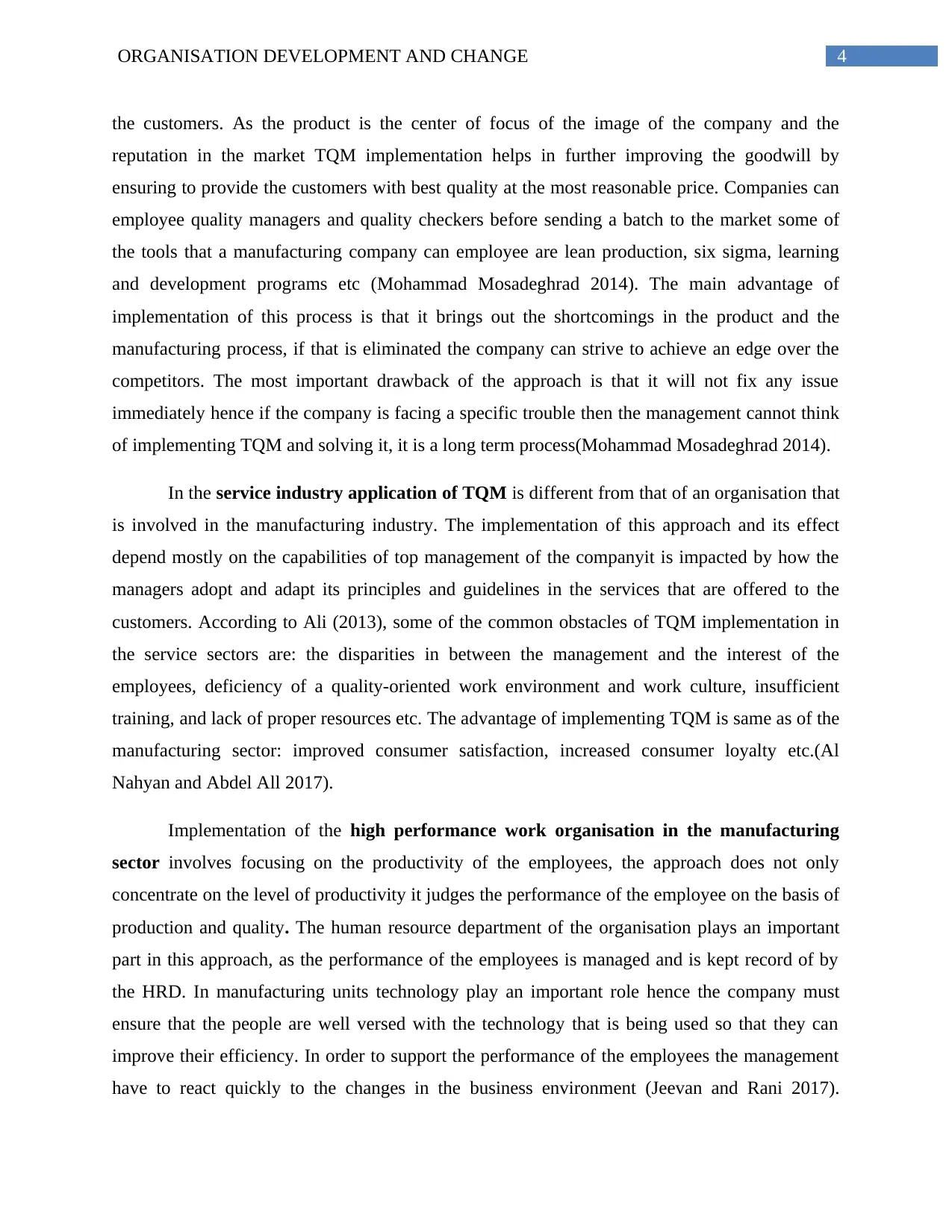
4ORGANISATION DEVELOPMENT AND CHANGE
the customers. As the product is the center of focus of the image of the company and the
reputation in the market TQM implementation helps in further improving the goodwill by
ensuring to provide the customers with best quality at the most reasonable price. Companies can
employee quality managers and quality checkers before sending a batch to the market some of
the tools that a manufacturing company can employee are lean production, six sigma, learning
and development programs etc (Mohammad Mosadeghrad 2014). The main advantage of
implementation of this process is that it brings out the shortcomings in the product and the
manufacturing process, if that is eliminated the company can strive to achieve an edge over the
competitors. The most important drawback of the approach is that it will not fix any issue
immediately hence if the company is facing a specific trouble then the management cannot think
of implementing TQM and solving it, it is a long term process(Mohammad Mosadeghrad 2014).
In the service industry application of TQM is different from that of an organisation that
is involved in the manufacturing industry. The implementation of this approach and its effect
depend mostly on the capabilities of top management of the companyit is impacted by how the
managers adopt and adapt its principles and guidelines in the services that are offered to the
customers. According to Ali (2013), some of the common obstacles of TQM implementation in
the service sectors are: the disparities in between the management and the interest of the
employees, deficiency of a quality-oriented work environment and work culture, insufficient
training, and lack of proper resources etc. The advantage of implementing TQM is same as of the
manufacturing sector: improved consumer satisfaction, increased consumer loyalty etc.(Al
Nahyan and Abdel All 2017).
Implementation of the high performance work organisation in the manufacturing
sector involves focusing on the productivity of the employees, the approach does not only
concentrate on the level of productivity it judges the performance of the employee on the basis of
production and quality. The human resource department of the organisation plays an important
part in this approach, as the performance of the employees is managed and is kept record of by
the HRD. In manufacturing units technology play an important role hence the company must
ensure that the people are well versed with the technology that is being used so that they can
improve their efficiency. In order to support the performance of the employees the management
have to react quickly to the changes in the business environment (Jeevan and Rani 2017).
the customers. As the product is the center of focus of the image of the company and the
reputation in the market TQM implementation helps in further improving the goodwill by
ensuring to provide the customers with best quality at the most reasonable price. Companies can
employee quality managers and quality checkers before sending a batch to the market some of
the tools that a manufacturing company can employee are lean production, six sigma, learning
and development programs etc (Mohammad Mosadeghrad 2014). The main advantage of
implementation of this process is that it brings out the shortcomings in the product and the
manufacturing process, if that is eliminated the company can strive to achieve an edge over the
competitors. The most important drawback of the approach is that it will not fix any issue
immediately hence if the company is facing a specific trouble then the management cannot think
of implementing TQM and solving it, it is a long term process(Mohammad Mosadeghrad 2014).
In the service industry application of TQM is different from that of an organisation that
is involved in the manufacturing industry. The implementation of this approach and its effect
depend mostly on the capabilities of top management of the companyit is impacted by how the
managers adopt and adapt its principles and guidelines in the services that are offered to the
customers. According to Ali (2013), some of the common obstacles of TQM implementation in
the service sectors are: the disparities in between the management and the interest of the
employees, deficiency of a quality-oriented work environment and work culture, insufficient
training, and lack of proper resources etc. The advantage of implementing TQM is same as of the
manufacturing sector: improved consumer satisfaction, increased consumer loyalty etc.(Al
Nahyan and Abdel All 2017).
Implementation of the high performance work organisation in the manufacturing
sector involves focusing on the productivity of the employees, the approach does not only
concentrate on the level of productivity it judges the performance of the employee on the basis of
production and quality. The human resource department of the organisation plays an important
part in this approach, as the performance of the employees is managed and is kept record of by
the HRD. In manufacturing units technology play an important role hence the company must
ensure that the people are well versed with the technology that is being used so that they can
improve their efficiency. In order to support the performance of the employees the management
have to react quickly to the changes in the business environment (Jeevan and Rani 2017).
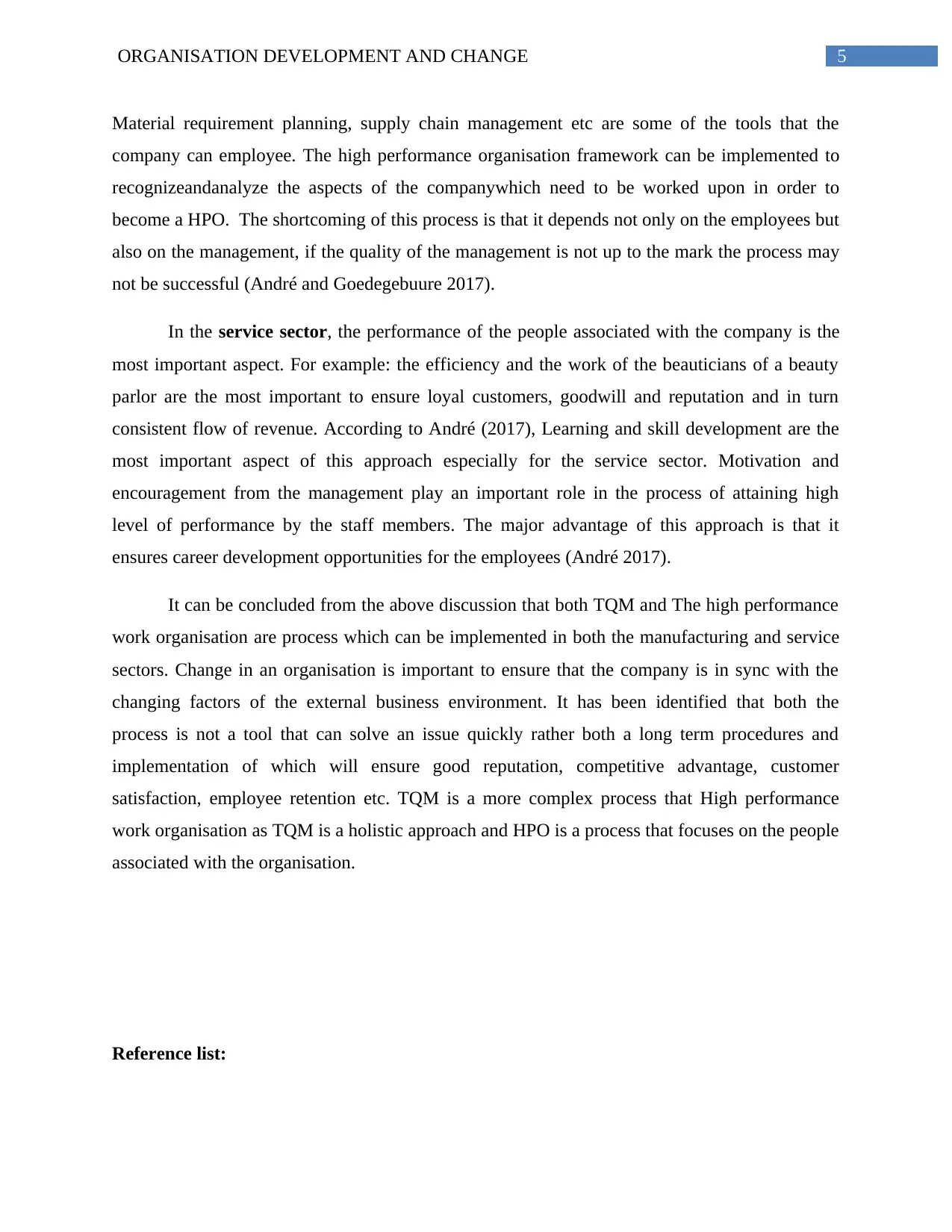
5ORGANISATION DEVELOPMENT AND CHANGE
Material requirement planning, supply chain management etc are some of the tools that the
company can employee. The high performance organisation framework can be implemented to
recognizeandanalyze the aspects of the companywhich need to be worked upon in order to
become a HPO. The shortcoming of this process is that it depends not only on the employees but
also on the management, if the quality of the management is not up to the mark the process may
not be successful (André and Goedegebuure 2017).
In the service sector, the performance of the people associated with the company is the
most important aspect. For example: the efficiency and the work of the beauticians of a beauty
parlor are the most important to ensure loyal customers, goodwill and reputation and in turn
consistent flow of revenue. According to André (2017), Learning and skill development are the
most important aspect of this approach especially for the service sector. Motivation and
encouragement from the management play an important role in the process of attaining high
level of performance by the staff members. The major advantage of this approach is that it
ensures career development opportunities for the employees (André 2017).
It can be concluded from the above discussion that both TQM and The high performance
work organisation are process which can be implemented in both the manufacturing and service
sectors. Change in an organisation is important to ensure that the company is in sync with the
changing factors of the external business environment. It has been identified that both the
process is not a tool that can solve an issue quickly rather both a long term procedures and
implementation of which will ensure good reputation, competitive advantage, customer
satisfaction, employee retention etc. TQM is a more complex process that High performance
work organisation as TQM is a holistic approach and HPO is a process that focuses on the people
associated with the organisation.
Reference list:
Material requirement planning, supply chain management etc are some of the tools that the
company can employee. The high performance organisation framework can be implemented to
recognizeandanalyze the aspects of the companywhich need to be worked upon in order to
become a HPO. The shortcoming of this process is that it depends not only on the employees but
also on the management, if the quality of the management is not up to the mark the process may
not be successful (André and Goedegebuure 2017).
In the service sector, the performance of the people associated with the company is the
most important aspect. For example: the efficiency and the work of the beauticians of a beauty
parlor are the most important to ensure loyal customers, goodwill and reputation and in turn
consistent flow of revenue. According to André (2017), Learning and skill development are the
most important aspect of this approach especially for the service sector. Motivation and
encouragement from the management play an important role in the process of attaining high
level of performance by the staff members. The major advantage of this approach is that it
ensures career development opportunities for the employees (André 2017).
It can be concluded from the above discussion that both TQM and The high performance
work organisation are process which can be implemented in both the manufacturing and service
sectors. Change in an organisation is important to ensure that the company is in sync with the
changing factors of the external business environment. It has been identified that both the
process is not a tool that can solve an issue quickly rather both a long term procedures and
implementation of which will ensure good reputation, competitive advantage, customer
satisfaction, employee retention etc. TQM is a more complex process that High performance
work organisation as TQM is a holistic approach and HPO is a process that focuses on the people
associated with the organisation.
Reference list:
⊘ This is a preview!⊘
Do you want full access?
Subscribe today to unlock all pages.

Trusted by 1+ million students worldwide
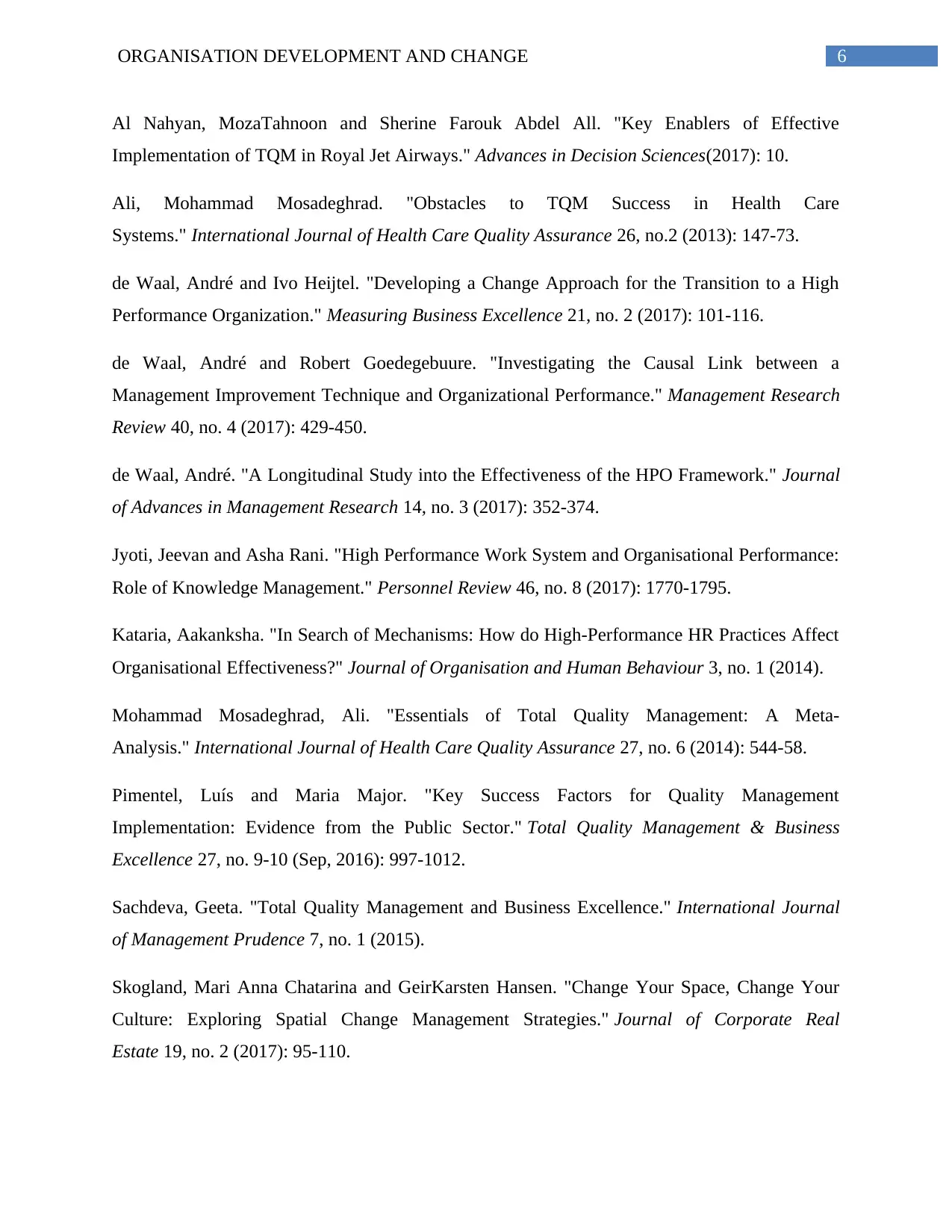
6ORGANISATION DEVELOPMENT AND CHANGE
Al Nahyan, MozaTahnoon and Sherine Farouk Abdel All. "Key Enablers of Effective
Implementation of TQM in Royal Jet Airways." Advances in Decision Sciences(2017): 10.
Ali, Mohammad Mosadeghrad. "Obstacles to TQM Success in Health Care
Systems." International Journal of Health Care Quality Assurance 26, no.2 (2013): 147-73.
de Waal, André and Ivo Heijtel. "Developing a Change Approach for the Transition to a High
Performance Organization." Measuring Business Excellence 21, no. 2 (2017): 101-116.
de Waal, André and Robert Goedegebuure. "Investigating the Causal Link between a
Management Improvement Technique and Organizational Performance." Management Research
Review 40, no. 4 (2017): 429-450.
de Waal, André. "A Longitudinal Study into the Effectiveness of the HPO Framework." Journal
of Advances in Management Research 14, no. 3 (2017): 352-374.
Jyoti, Jeevan and Asha Rani. "High Performance Work System and Organisational Performance:
Role of Knowledge Management." Personnel Review 46, no. 8 (2017): 1770-1795.
Kataria, Aakanksha. "In Search of Mechanisms: How do High-Performance HR Practices Affect
Organisational Effectiveness?" Journal of Organisation and Human Behaviour 3, no. 1 (2014).
Mohammad Mosadeghrad, Ali. "Essentials of Total Quality Management: A Meta-
Analysis." International Journal of Health Care Quality Assurance 27, no. 6 (2014): 544-58.
Pimentel, Luís and Maria Major. "Key Success Factors for Quality Management
Implementation: Evidence from the Public Sector." Total Quality Management & Business
Excellence 27, no. 9-10 (Sep, 2016): 997-1012.
Sachdeva, Geeta. "Total Quality Management and Business Excellence." International Journal
of Management Prudence 7, no. 1 (2015).
Skogland, Mari Anna Chatarina and GeirKarsten Hansen. "Change Your Space, Change Your
Culture: Exploring Spatial Change Management Strategies." Journal of Corporate Real
Estate 19, no. 2 (2017): 95-110.
Al Nahyan, MozaTahnoon and Sherine Farouk Abdel All. "Key Enablers of Effective
Implementation of TQM in Royal Jet Airways." Advances in Decision Sciences(2017): 10.
Ali, Mohammad Mosadeghrad. "Obstacles to TQM Success in Health Care
Systems." International Journal of Health Care Quality Assurance 26, no.2 (2013): 147-73.
de Waal, André and Ivo Heijtel. "Developing a Change Approach for the Transition to a High
Performance Organization." Measuring Business Excellence 21, no. 2 (2017): 101-116.
de Waal, André and Robert Goedegebuure. "Investigating the Causal Link between a
Management Improvement Technique and Organizational Performance." Management Research
Review 40, no. 4 (2017): 429-450.
de Waal, André. "A Longitudinal Study into the Effectiveness of the HPO Framework." Journal
of Advances in Management Research 14, no. 3 (2017): 352-374.
Jyoti, Jeevan and Asha Rani. "High Performance Work System and Organisational Performance:
Role of Knowledge Management." Personnel Review 46, no. 8 (2017): 1770-1795.
Kataria, Aakanksha. "In Search of Mechanisms: How do High-Performance HR Practices Affect
Organisational Effectiveness?" Journal of Organisation and Human Behaviour 3, no. 1 (2014).
Mohammad Mosadeghrad, Ali. "Essentials of Total Quality Management: A Meta-
Analysis." International Journal of Health Care Quality Assurance 27, no. 6 (2014): 544-58.
Pimentel, Luís and Maria Major. "Key Success Factors for Quality Management
Implementation: Evidence from the Public Sector." Total Quality Management & Business
Excellence 27, no. 9-10 (Sep, 2016): 997-1012.
Sachdeva, Geeta. "Total Quality Management and Business Excellence." International Journal
of Management Prudence 7, no. 1 (2015).
Skogland, Mari Anna Chatarina and GeirKarsten Hansen. "Change Your Space, Change Your
Culture: Exploring Spatial Change Management Strategies." Journal of Corporate Real
Estate 19, no. 2 (2017): 95-110.
1 out of 7
Related Documents
Your All-in-One AI-Powered Toolkit for Academic Success.
+13062052269
info@desklib.com
Available 24*7 on WhatsApp / Email
![[object Object]](/_next/static/media/star-bottom.7253800d.svg)
Unlock your academic potential
Copyright © 2020–2025 A2Z Services. All Rights Reserved. Developed and managed by ZUCOL.





